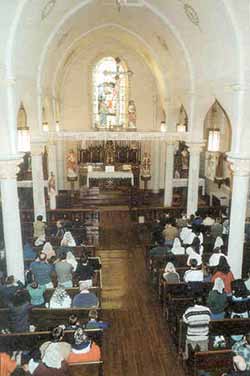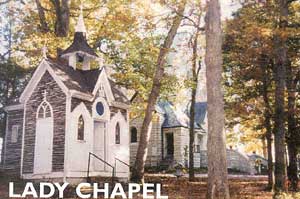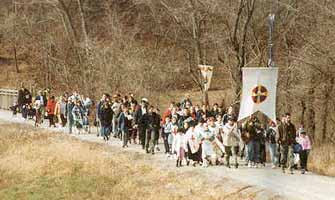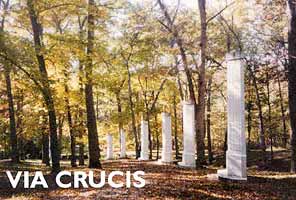STARKENBURG
The history of the Shrine of Our Lady of Sorrows in Starkenburg, Missouri, begins in 1887 when Fr. George Hoehn was appointed pastor to St. Martin's Catholic Church. The church was situated on Missour River bottom land called Rhineland or Loutre Island [loutre is French for otter], a settled area without a specific name. During the 38 years Fr. Hoehn spent here he became the Shrine's most zealous publicist.
He was born in Heppenheim in 1856 in the southwest part of Germany. He lost both his parents at age three. He came to the United States at age 16, worked odd jobs, even opened a religious goods store near SS. Peter and Paul Catholic Church in St. Louis, Missouri. He studied for the priesthood at St. Francis Seminary, Milwaukee, Wisconsin, and finished his formation at the University of Louvain in Belgium. He was ordained at age 30 (1886). Nine priests credited their priesthood to his example–seven from Germany and two from Missouri.
The town name of "Starkenburg" came from Fr. Hoehn. In 1891, he applied for a post office box because of the amount of mail coming into the area and was required to give a name to complete the forms. Looking at the surrounding hills and the St. Martin's parish church rising high above them, its 125-foot steeple piercing the sky over the river valley, he thought of the likeness to his birthplace in Heppenheim and the hill rising up from it to the fortress called "Starkenburg," a name meaning "strong fort" in German. The Starkenburg fortress had been built in 1025 by monks of the monastery of Lorsch as protection for the abbey against the political and ecclesiastical machinations of Adalbert, Archbishop of Hamburg-Mainz. After 1232, Starkenburg became a kind of military headquarters for guarding the lands of the Chancellor of the Roman Empire and the Archbishop of Mainz. It was seized in 1620 by the Counts of the Palatinate, a German state which had apostatized from the Faith in the protestant revolution which had overwhelmed northern Germany. After its long resistance–for justice within the Church herself and then in opposition to the protestant revolt attacking her–the Starkenburg fortress was taken over by the German state of Hessen in 1803.
 |
|
Fr. Hoehn died in 1943 and was buried in the convent cemetery of the Precious Blood Sisters at O'Fallon, Missouri. Before he died, he built a small chapel at the base of the Starkenburg hill in Heppenheim. He dedicated it to "Our Lady of Starkenburg, Missouri" and had carved for its altar a copy of the White Lady of Starkenburg (about whom we will now learn).
In 1852 the parish church of St. Martin (in what would be finally called Starkenburg) was only a humble log building. It possessed a plain white statue of the Mother of God for whom the German immigrant Catholics of the bottom lands had great devotion. This statue became known as the "White Lady" because of the white veil which adorned it. Our Lady has been known under this name ever since.
In 1873, the original log church of St. Martin's was replaced by one of stone and soon after a larger statue replaced the White Lady. In 1888, the old faded White Lady was discovered in the rectory attic by August Mitsch, the young nephew of Fr. Hoehn who brought him from Heppenheim to enter religious life in America. He put the image on a small altar he built under a canopy of dogwood. He started his daily May devotions and was soon joined by children and neighbors. Old timers recognized the White Lady and devotion to her was rekindled in the parishioners. May passed, but instead of returning the image to storage, Mitsch and two seminarians built a small log hut for its protection. Many of the faithful frequented the woodland shrine, and the hut was replaced by the small chapel shrine. This chapel shrine still stands.
In November, 1888, August Mitsch left for the Marianist Novitiate in Dayton, Ohio, the first such vocation from Missouri. On March 31, 1889, following a retreat, he made the promises of the novitiate, but suddenly became seriously ill and was forced to return to Starkenburg to recover. His first walk took him to the Lady Chapel in the woods. A month later 19-year-old August died. It was June 20, the anniversary of the death of St. Aloysius Gonzaga, Patron of Youth, whom he had chosen as his model. He passed away at Alexian Brothers hospital in St. Louis and was laid to rest in SS. Peter and Paul Cemetery there. His uncle, Fr. Hoehn, insisted he be buried at Starkenburg. In 1916, his remains were brought back by train from St. Louis, and by horse and wagon from nearby Rhineland, Missouri. His grave is marked with a headstone (circled, see p. 22) near the log Lady Chapel he built.

The Lady Chapel shrine in the woods was visited often by area Catholics and its fame spread. In the 1890's, the newly-laid Missouri-Kansas-Texas Railroad [a.k.a. the MKT Railroad and nicknamed the KATY Railroad–Ed.] brought pilgrims west from St. Louis and east from the American Southwest. Pilgrims began to come from all directions.
In 1889, on the Feast of Seven Sorrows of Our Lady (Sept. 15), the first Way of the Cross was erected with the approval of St. Louis Archbishop Peter Kenrick in the woods near the Lady Chapel. These original stations were placed under glass in simple wooden cases raised on posts. The woodland received a special blessing and no cattle or vehicles were permitted to cross the premises. In 1901, a native of Westphalia, Kansas, having received great consolation while visiting Starkenburg, offered to buy a more durable series of Stations, but they too succumbed to deterioration and were replaced in 1950 by the Stations of reinforced concrete that pilgrims see today. At this time, between the first and last Stations, an underground sepulcher was built where an image of the dead Christ lies with a Calvary grouping erected atop it.
Over the years the image of the White Lady had begun to look weather-beaten. In 1890, Catholics from St. Louis donated an image of the Pieta (circled in picture on this page) from Dusseldorf, Germany, to the Shrine. It was made in Dusseldorf, Germany. It was used in processions and is now enshrined on a side altar of the 1910 church. The White Lady was once again retired to storage.
In 1891, six weeks of rain halted the building of a tower and addition to the old St. Martin's parish church and threatened to destroy the harvest. Fr. Hoehn invited the parish to join him in vowing to sponsor an annual pilgrimage in honor of Our Lady of Sorrows if the imminent danger were averted. And it was. The rains subsided and a bumper wheat crop was harvested. In the same year, the parish gave thanks for three days ending with a solemn procession to the log Lady Chapel in the woods. While numerous private pilgrimages had been made already by parishioners, this was the first public pilgrimage observed in Starkenburg. A year later, 40 Catholics from Hermann, Missouri, were the first non-parishioners to make the pilgrimage as part of a mission conducted by two Redemptorist priests.

A drought threatened the corn crop in 1894 and again the parishioners gathered at the shrine where they spent the whole day in prayer. The object inspiring their veneration was the Pieta, the Sorrowful Mother veiled by a mantle of fine material. During the night, a fire started from an unknown cause, consumed the altar linens and burned deep holes into the altar, but the Pieta which stood in the center of the flames was not touched. The next day, the drought broke and the corn crop was saved. From that time, public pilgrimages increased every year.
On July 27, 1897, Pope Leo XIII officially granted plenary indulgences, at certain times and under the usual conditions of a good Confession, reception of Holy Communion, and prayers before the holy image of the Pieta, to pilgrims who visited the Shrine. This further encouraged pilgrimages to Starkenburg.

Early pilgrims found lodging in the homes of farmers. The St. Martin's schoolhouse was used as a dormitory for women. Men and boys often slept in haylofts. By 1899, the men of St. Martin's had built a Pilgrim House to accommodate 100. Parish women took over furnishing bedding. In the basement, they set up kitchen facilities. Even with the Pilgrim House, the parish schoolhouse, rectory, and convent often had to be opened to pilgrims. Over the years, these buildings have succumbed to age and fire and have been razed. In 1964, the existing cafeteria hall was constructed.
|
Blessing of the Scrip
Serious pilgrimages are identified by an item characteristic of the saint(s) in whose memory and for whose intercession that pilgrimage is made.This item is called the "scrip." For instance, for the pilgrimage to Santiago de Compostella (St. James) it is a shell for reason that much of the Camino Real is along Spain's northern seashore.The scrip for the pilgrimage to St. Olaf's in Norway is an axe head, the instrument of his martyrdom. Pilgrims to Jerusalem wear a cross. They are blessed by the priest before departure:
Let it be suggested that the official scrip of the Starkenburg Pilgrimage be a white handkerchief, pinned to the arm or knotted about the neck, in honor of the veiled "White Lady," Our Lady of Sorrows. |
At the foot of the hill upon which the shrine churches are built lies the Grotto of Lourdes. Early on, parishioners placed a picture of the Immaculate Conception in a stone enclosure they made for its protection. Later a replica of the Lourdes Grotto was constructed. Up to now, some maintained that Starkenburg was not a genuine place of pilgrimage, much less a place of grace. Fr. Hoehn prayed that some sign of authenticity might be granted from Heaven. There was no water at the Grotto and he prayed to the Blessed Mother for a fountain of fresh water. Against the protests of area farmers who disbelieved water would be found here, a well was dug at the site. After three days digging, on September 3, 1900, the Feast of Mary, Comfortress of the Afflicted, a spring was struck. The next year, a drought came upon the area, cisterns and creeks went dry, but not the Lourdes Well (circled above). Shortly after the well had been dug, Fr. Hoehn went to France. To affiliate the Starkenburg well with that of Lourdes, he brought back from Lourdes a large container of its water which he poured into the Starkenburg well.
 |
No official claims have ever been made for healing power either by drinking or touching the water of the Starkenburg Lourdes Well, but there are reports of cures. A notable case is that of Sr. Vera, a Loretto sister teaching at Webster College, Kansas City, who visited the Grotto in 1940 suffering from a large cyst in the throat which was to require a serious operation. She drank the water of the Starkenburg well. Upon presenting herself for the operation, no trace of the cyst could be found. In 1970, Sr. Vera signed a statement testifying that no sign of the cyst had returned.
Also in 1940, a crowd from St. Stephen's of St. Louis, Missouri, honored the statue of the Sorrowful Mother with a gold crown in thanksgiving for an apparently miraculous cure of a crippled girl of the parish during a pilgrimage in 1939.
In 1934, the Grotto was rebuilt by Bro. Michael Brown, an Oblate of Mary. He was called to serve in World War II (1942), was later reported missing, and eventually declared dead somewhere in the Pacific theater.
In 1895, Archbishop John Kain of St. Louis came to Starkenburg to administer the Sacrament of Confirmation. His grace preached on the greatness of Mary and concluded by saying: "May the pilgrims come from far and near to this place to gaze at the face of our Sorrowful Mother and find therein consolation and peace for their aching hearts." In 1906, on the same spot where Archbishop Kain uttered these words, the friends of Our Lady of Sorrows began to erect a handsome Romanesque chapel built of native stone. Funds were raised through Fr. Hoehn's monthly magazine, Der Pilger (The Pilgrim), and plans came from a contractor in Mainz, Germany. Neighboring farmers donated rocks for the foundation. During the winter when trees are barren, one can still see the rocky hillsides to the east from which these rocks came. Men dug the foundation trench six feet deep and eight feet wide–the walls of the shrine church are eight feet thick–and saw Fr. Hoehn set the first stone in the trench on the Feast of the Holy Redeemer (Oct. 23, 1906). On May 24, Feast of Mary Help of Christians, the foundation had been built up to ground level and the church cornerstone was laid. The document placed in the cornerstone reads:
The cornerstone was laid in honor of Christ, the Eternal King, and in honor of His most amiable Mother, the Blessed Virgin Mary, the Help of Christians, on the 24th day of May, 1908, on the 5th Sunday after Easter during the reign of Pope Pius X whilst John Joseph Glennon was Archbishop of St. Louis, and George Hoehn, Pastor of St. Martin's Parish....
Since the new shrine church was to be on the site of the dogwood bush where the original devotion to Our Lady was begun, the log chapel had to be moved on skids a short ways to where it now stands. As it was moved, its small bell squeaked so terribly that the carpenters searched for some oil. Finding none, some butter was procured from the rectory housekeeper with which to grease the bell bracket. The job done, the bell tower was inscribed in German, "This bell for the Holy Mother has now been greased with butter."
On July 16, 1910, the Feast of Our Lady of Mt. Carmel, a cross measuring seven feet high was raised and placed on the steeple. The bell in the 67-foot tower was donated by the same Kansas pilgrim who had donated the second series of Stations. The bell was blessed on the Feast of the Holy Name of Mary (Sept. 12) and solemnly dedicated to the Holy Archangel Gabriel.
On September 14, the White Lady, rescued from storage and painted, was enthroned under the marble baldacchino of the main altar where it is today. The next day, Feast of Our Lady of Sorrows, Archbishop Glennon arrived for a day of dedication ceremonies attended by many priests, three Starkenburg seminarians, and hundreds of pilgrims.
In 1912, Fr. Hoehn brought from Germany a small stone of the old Starkenburg fortress which was mortared into the east wall of the shrine church. A plaque designates this stone.
Crutches, braces, and marble plaques line the walls of the side chapel of the Pieta, bearing testimony to the faith and gratitude of the pilgrims who obtained consolation and relief through the intercession of Our Lady. One of the plaques containing "Danke"–Thank you–was placed there in 1908 by a young student (circled, see pp. 20, 21) with a growth which suddenly appeared on his hand. With prayer and use of the holy water from the Starkenburg Lourdes Well it disappeared and never returned. The student was Martin Hellriegel, one of the three St. Martin's seminarians who escorted Archbishop Glennon into the shrine church on the day of its dedication. He was later ordained, celebrated his first Mass in the Starkenburg shrine church (1914), and served as pastor at St. Martin's. He went on to become pastor for 40 years at Holy Cross Catholic Church in St. Louis, making of it a model of liturgical practice for Gregorian chant and service of the altar. Before his death in 1981, he partially repudiated his support of the Novus Ordo. He is the composer of the hymn, "Jesus Christ, Our Sovereign King." He is responsible for the conversion of Ernest Beck, a protestant minister ordained a Catholic priest, who celebrated exclusively the Latin Mass for 40-50 people in Wilmington, North Carolina, until his death.
In 1925, Fr. Hoehn sought the help of a religious order to entrust care of the Shrine. An invitation was accepted by the Oblates of Mary who had a Minor Seminary in nearby Belleville, Illinois, and who knew the Shrine well. The Oblates were charged to care for the Shrine for 35 years. Remarkable among the Oblates who did this was Fr. Aloysius Rosenthal, who was responsible for the Shrine from 1934-43. These years saw a heavy influx of pilgrims. A special KATY Railroad train was run on the two big pilgrimage days, the third Sunday in May and the second Sunday in September. As many as 3,000 people attended these annual pilgrimages regularly.
With the start of World War II, however, the rationing of gas and tires and the inability to get trains took its toll on pilgrimage attendance. Starkenburg was cut from the St. Louis diocese and put into the new Jefferson City, Missouri, diocese. This created a shortage of priests to care for the Shrine site. In 1960, the duties of St. Martin's parish and nearby St. Joseph's of Rhineland were assigned to a single priest. The Oblates of Mary reluctantly gave up care of the Shrine. The numbers of pilgrims and pilgrimages declined drastically. In 1970, a lay organization was established to care for the Shrine. One of the first necessities was to raise funds for repairs, maintenance, improvements, and exposure. A museum was opened in 1970. It is located in the sacristy behind the main altar of the old St. Martin's parish church. The lay organization is now independent of the founding parish, St. Martin's, which has since been renamed Risen Savior Church. The Shrine is open year-round. It is located 75 miles west of St. Louis, or 170 miles east of Kansas City on I-70; then take Hwy. 19 south for 7 miles to Big Spring; then Hwy. K west 6 miles to Hwy. P. and travel south for 4 miles to Starkenburg.
Since 1999, the Society of Saint Pius X has sponsored each fall the Starkenburg Pilgrimage for various intentions. The route is 12 miles long starting in Portland, Missouri, and follows the rails-to-trails gravel path of the old Missouri-Kansas-Texas Railroad (known as the KATY Trail) along the Missouri River.
The 2004 Starkenburg Pilgrimage will be Saturday, October 23. Regional chapels will be sent information packets in advance; otherwise call or write Mrs. Frances Bullock, 3110 Flora Ave., Kansas City, MO, 64109. Tel. 816-923-6411.
Photographs taken by Fr. Kenneth Novak, Miss Caroline Awerkamp, and Mr. David Kleinsmith.
